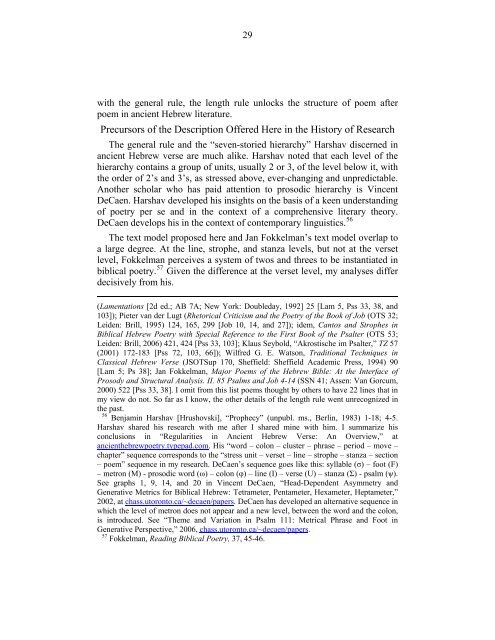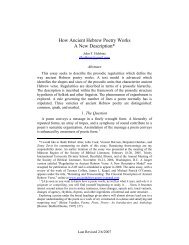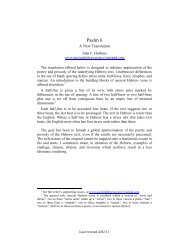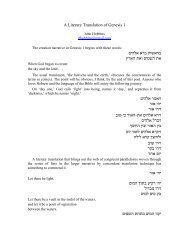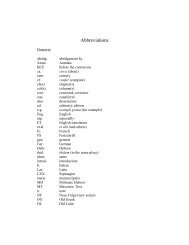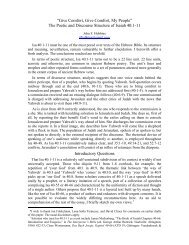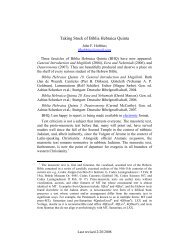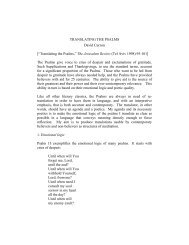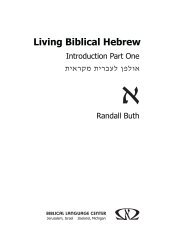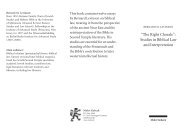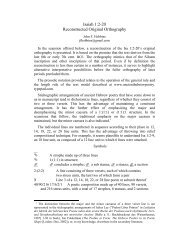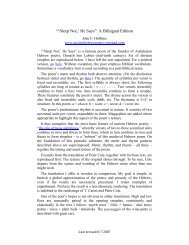Here - Ancient Hebrew Poetry - Typepad
Here - Ancient Hebrew Poetry - Typepad
Here - Ancient Hebrew Poetry - Typepad
- No tags were found...
Create successful ePaper yourself
Turn your PDF publications into a flip-book with our unique Google optimized e-Paper software.
29with the general rule, the length rule unlocks the structure of poem afterpoem in ancient <strong>Hebrew</strong> literature.Precursors of the Description Offered <strong>Here</strong> in the History of ResearchThe general rule and the “seven-storied hierarchy” Harshav discerned inancient <strong>Hebrew</strong> verse are much alike. Harshav noted that each level of thehierarchy contains a group of units, usually 2 or 3, of the level below it, withthe order of 2’s and 3’s, as stressed above, ever-changing and unpredictable.Another scholar who has paid attention to prosodic hierarchy is VincentDeCaen. Harshav developed his insights on the basis of a keen understandingof poetry per se and in the context of a comprehensive literary theory.DeCaen develops his in the context of contemporary linguistics. 56The text model proposed here and Jan Fokkelman’s text model overlap toa large degree. At the line, strophe, and stanza levels, but not at the versetlevel, Fokkelman perceives a system of twos and threes to be instantiated inbiblical poetry. 57 Given the difference at the verset level, my analyses differdecisively from his.(Lamentations [2d ed.; AB 7A; New York: Doubleday, 1992] 25 [Lam 5, Pss 33, 38, and103]); Pieter van der Lugt (Rhetorical Criticism and the <strong>Poetry</strong> of the Book of Job (OTS 32;Leiden: Brill, 1995) 124, 165, 299 [Job 10, 14, and 27]); idem, Cantos and Strophes inBiblical <strong>Hebrew</strong> <strong>Poetry</strong> with Special Reference to the First Book of the Psalter (OTS 53;Leiden: Brill, 2006) 421, 424 [Pss 33, 103]; Klaus Seybold, “Akrostische im Psalter,” TZ 57(2001) 172-183 [Pss 72, 103, 66]); Wilfred G. E. Watson, Traditional Techniques inClassical <strong>Hebrew</strong> Verse (JSOTSup 170, Sheffield: Sheffield Academic Press, 1994) 90[Lam 5; Ps 38]; Jan Fokkelman, Major Poems of the <strong>Hebrew</strong> Bible: At the Interface ofProsody and Structural Analysis. II. 85 Psalms and Job 4-14 (SSN 41; Assen: Van Gorcum,2000) 522 [Pss 33, 38]. I omit from this list poems thought by others to have 22 lines that inmy view do not. So far as I know, the other details of the length rule went unrecognized inthe past.56 Benjamin Harshav [Hrushovski], “Prophecy” (unpubl. ms., Berlin, 1983) 1-18; 4-5.Harshav shared his research with me after I shared mine with him. I summarize hisconclusions in “Regularities in <strong>Ancient</strong> <strong>Hebrew</strong> Verse: An Overview,” atancienthebrewpoetry.typepad.com. His “word – colon – cluster – phrase – period – move –chapter” sequence corresponds to the “stress unit – verset – line – strophe – stanza – section– poem” sequence in my research. DeCaen’s sequence goes like this: syllable (σ) – foot (F)– metron (M) - prosodic word (ω) – colon (φ) – line (I) – verse (U) – stanza (Σ) - psalm (ψ).See graphs 1, 9, 14, and 20 in Vincent DeCaen, “Head-Dependent Asymmetry andGenerative Metrics for Biblical <strong>Hebrew</strong>: Tetrameter, Pentameter, Hexameter, Heptameter,”2002, at chass.utoronto.ca/~decaen/papers. DeCaen has developed an alternative sequence inwhich the level of metron does not appear and a new level, between the word and the colon,is introduced. See “Theme and Variation in Psalm 111: Metrical Phrase and Foot inGenerative Perspective,” 2006, chass.utoronto.ca/~decaen/papers.57 Fokkelman, Reading Biblical <strong>Poetry</strong>, 37, 45-46.


